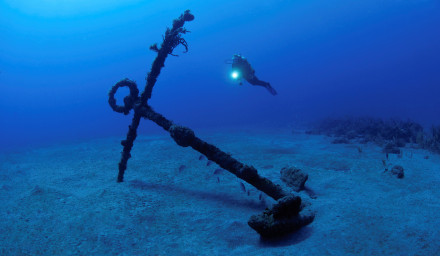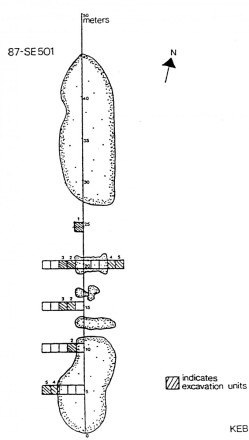History
Background
A number of shipwrecks have been identified in the Oranje Bay of Sint Eustatius which have been given names starting with SE.
SE-501, located approximately 650 meters from shore, is a popular dive site, also called the Double Wreck (it is unclear what the source of this name is). This site lies in the central area of the historic roadstead of Sint Eustatius. In the eighteenth century, thousands of ships dropped anchor here in order to trade at this free port. The Double Wreck is 45 meters long, 7.5 meters wide, and oriented in a north-south direction along its main axis. It consists of five separate ballast piles which are located on a sandy bottom at a depth of 18 meters. The ballast stones are completely overgrown with a variety of sponges and corals and inhabited by large numbers of fish and invertebrates. Most wood has been completely destroyed by shipworm (Teredo navalis), a species of saltwater clam that is notorious for burrowing through submerged wood. The northern part’s narrowing shape may indicate the bow of the ship, while the southern part’s rounding in the ballast structure may be indicative of the stern.

Description
Period: late 18th to mid-19th century.
Origin: English or Dutch
Status
From 1987 to 1988, ten 1 x 2 meter test trenches to depths of around one meter were excavated by East Carolina University, below which a hard layer of rocks and dead coral was found that proved impossible to excavate. 104 artefacts were recovered and these included red, orange, and yellow bricks, clay tobacco pipe fragments, glass bottle fragments, a large variety of ceramics, and several metal objects. Based on the artifact assemblage, these investigators concluded that this vessel dates from the late eighteenth to the mid-nineteenth century and possibly may be of English or Dutch origin (Bequette 1992, p. 136).

References
- Kathryn Bequette (1992).
An Archaeological Reconnaissance of the Anchorage, Seawalls, and Shipwrecks within Oranje Bay, St. Eustatius, Netherlands Antilles.
East Carolina University. - Ruud Stelten (2019).
From Golden Rock to Historic Gem: A Historical Archaeological Analysis of the Maritime Cultural Landscape of St. Eustatius Dutch Caribbean.
Leiden: Sidestone Press.